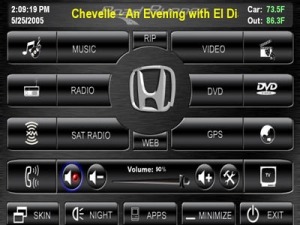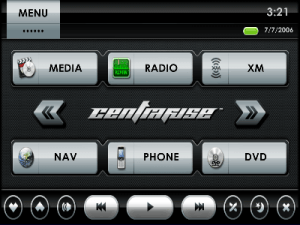Car PC: Part 3 – Software
Part three of the Car PC saga :D
Now that the PC itself was up and running and the screen and mount were completed, it was time to work on the insides of the beast, so to speak: the software – the thing that makes everything work!
The Backend
The PC itself was based on an extremely cut down version of Windows XP SP2. I removed unecessary features, slipstreamed hotfixes and drivers, and pre-installed some tweaks making a totally unattended installation that automatically installed everything I needed. This created a small install footprint and made the OS very quick to boot from cold / resume from hibernation.
I did experiment with using a 4GB compact flash card and CF -> IDE adapter as a boot drive mainly for the speed advantage (and solid state advantage), but due to the limited write cycles on CF cards, installing a standard version of XP (dynamically) would severely reduce the lifetime of the card. There are solutions to this (eg, using XP Embedded from Microsoft), but that involves a lot of hassle, so I opted to go for the old fashioned mechanical hard drive.
The entire system was tested indoors using a regular ATX power supply for ease of troubleshooting any problems – especially with the multitude of USB devices being used. Bluetooth partnerships were created with headsets and phones and COM ports configured for the GPS reciever and FM radio. When the system was found to be stable and with everything fully functional in it’s barebones OS state, it was time to install and configure the frontend.
The Frontend
The frontend is essentially what you see when you look at the screen. It is the software that is running and gives the user the functionality required from the PC in the car environment. There are several front ends available for use – some free to use, some not. Which frontend you choose is down to personal preference and before making a decision I tested two of the biggest ones on the system:
RoadRunner
This front end is free to use and is customisable both in terms of plug-ins and skins. It links to other external applications to handle various functions. Eg. Audio playback is controlled by winamp, GPS navigation can be controlled by Freedrive/Mapmonkey (maps are required from “Destinator” but need to be purchased) and DVD playback could be handled by PowerDVD, for example. It has a large userbase, because it is free and does the job very well.
Centrafuse
The other frontend I tested out was Centrafuse. This one is not free to use (there is a trial available), and comes in several different versions – the price of each is determined by it’s feature set. Again, very easy to work with – perhaps more so than RoadRunner, and there are a lot of plug ins and a few skins available. Centrafuse handles the majority of functions independently (as far as I can tell) as it doesn’t seem to call on other external programs as much as RoadRunner. One point to note is that Centrafuse does seem a little more resource hungry compared to RR.
Each frontend is very easy to set up and get working for basic functionality but things like phone control and GPS are a little more involved.
Now that system is fully operational, all that remained was to transfer some multimedia (audio and video) onto the hard drive so that there would actually be something to play! When doing this, make sure all files have correct ID3 tags otherwise when the frontend reads them, if you try searching for something by listing albums or artists, it will be a mess…
Transferring material to the PC in my case was simply a case of connecting to the wireless network and accessing network shares containing the albums etc that I wanted. This method will also be used when the PC is installed as the wireless link works from the driveway without any issues.
With everything as I wanted it, the final stage was to install the whole lot in the car. See Part 4!




Did you use XPLite when reducing the size of the OS or did you do it all manually?
my guess is that he used nLite, which is much better than XPLite IMO
Yes, I used nLite – awesome utility – good for integrating specific drivers / updates and removing windows components / auto configuring settings on install.
how can i downlaod this raodrunner soft ware to my car pc
You can get RoadRunner (now called RideRunner) here http://www.nisuautomotive.com/